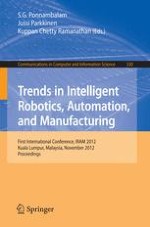2012 | Buch
Trends in Intelligent Robotics, Automation, and Manufacturing
First International Conference, IRAM 2012, Kuala Lumpur, Malaysia, November 28-30, 2012. Proceedings
herausgegeben von: S. G. Ponnambalam, Jussi Parkkinen, Kuppan Chetty Ramanathan
Verlag: Springer Berlin Heidelberg
Buchreihe : Communications in Computer and Information Science
